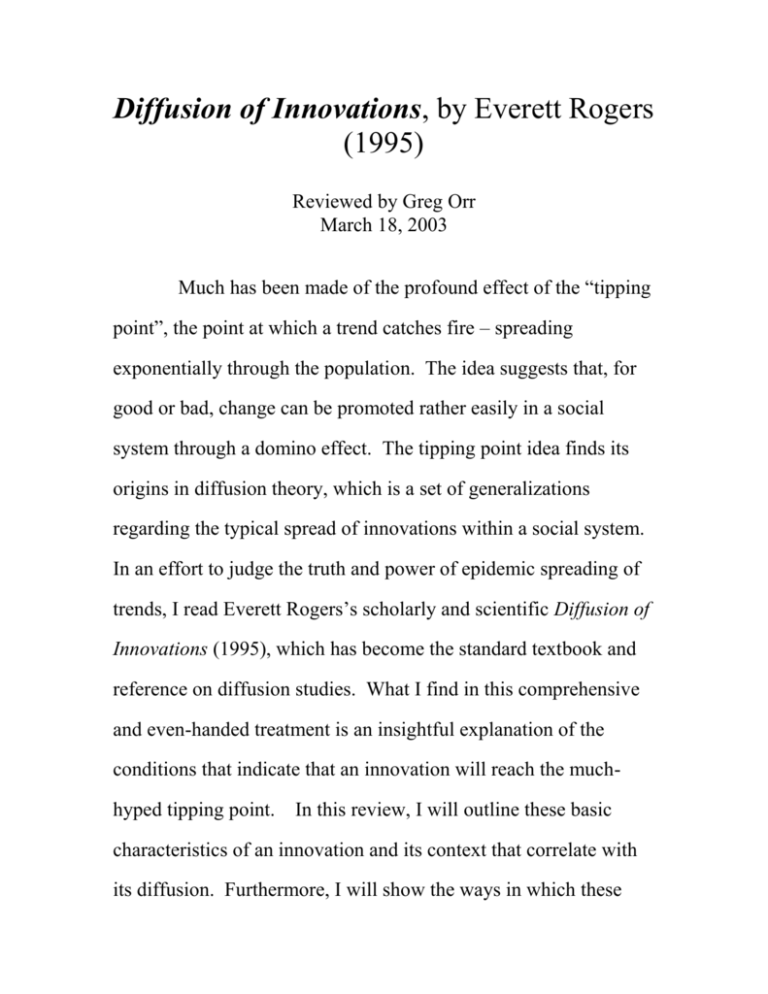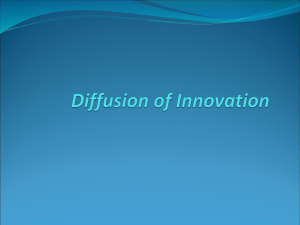Diffusion of Innovations, by Everett Rogers (1995)
advertisement

Diffusion of Innovations, by Everett Rogers (1995) Reviewed by Greg Orr March 18, 2003 Much has been made of the profound effect of the “tipping point”, the point at which a trend catches fire – spreading exponentially through the population. The idea suggests that, for good or bad, change can be promoted rather easily in a social system through a domino effect. The tipping point idea finds its origins in diffusion theory, which is a set of generalizations regarding the typical spread of innovations within a social system. In an effort to judge the truth and power of epidemic spreading of trends, I read Everett Rogers’s scholarly and scientific Diffusion of Innovations (1995), which has become the standard textbook and reference on diffusion studies. What I find in this comprehensive and even-handed treatment is an insightful explanation of the conditions that indicate that an innovation will reach the muchhyped tipping point. In this review, I will outline these basic characteristics of an innovation and its context that correlate with its diffusion. Furthermore, I will show the ways in which these understandings improve our capacity to take efficacious action to speed it up. At this point, I will be able to evaluate the claim that the tipping point makes it easy to spread change. The Mechanism of Diffusion Diffusion is the process by which an innovation is communicated through certain channels over time among the members of a social system (5). Given that decisions are not authoritative or collective, each member of the social system faces his/her own innovation-decision that follows a 5-step process (162): 1) Knowledge – person becomes aware of an innovation and has some idea of how it functions, 2) Persuasion – person forms a favorable or unfavorable attitude toward the innovation, 3) Decision – person engages in activities that lead to a choice to adopt or reject the innovation, 4) Implementation – person puts an innovation into use, 5) Confirmation – person evaluates the results of an innovation-decision already made. The most striking feature of diffusion theory is that, for most members of a social system, the innovation-decision depends heavily on the innovation-decisions of the other members of the system. In fact, empirically we see the successful spread of an innovation follows an S-shaped curve (23). There is, after about 10-25% of system members adopt an innovation, relatively rapid adoption by the remaining members and then a period in which the holdouts finally adopt. I will review Rogers’s assessment of the factors affecting the adoption of an innovation with the goal of elucidating how the earlier adopters of an innovation profoundly affect the innovation-decisions of later adopters. The innovation-decision is made through a cost-benefit analysis where the major obstacle is uncertainty. People will adopt an innovation if they believe that it will, all things considered, enhance their utility. So they must believe that the innovation may yield some relative advantage to the idea it supersedes (208). How can they know for sure that there are benefits? Also, in consideration of costs, people determine to what degree the innovation would disrupt other functioning facets of their daily life. Is it compatible with existing habits and values? Is it hard to use? The newness and unfamiliarity of an innovation infuse the cost-benefit analysis with a large dose of uncertainty. It sounds good, but does it work? Will it break? If I adopt it, will people think I’m weird? Since people are on average risk-averse, the uncertainty will often result in a postponement of the decision until further evidence can be gathered. But the key is that this is not the case for everyone. Each individual’s innovation-decision is largely framed by personal characteristics, and this diversity is what makes diffusion possible. For a successful innovation, the adopter distributions follow a bell-shaped curve, the derivative of the Sshaped diffusion curve, over time and approach normality (257). Diffusion scholars divide this bell-shaped curve to characterize five categories of system member innovativeness, where innovativeness is defined as the degree to which an individual is relatively earlier in adopting new ideas than other members of a system. These groups are: 1) innovators, 2) early adopters, 3) early majority, 4) late majority, and 5) laggards (262). The personal characteristics and interaction of these groups illuminates the aforementioned domino effect. Innovators are venturesome types that enjoy being on the cutting edge (263). The innovation’s possible benefits make it exciting; the innovators imagine the possibilities and are eager to give it a try. The implementation and confirmation stages of the innovators’ innovation-decisions are of particular value to the subsequent decisions of potential adopters. Early adopters use the data provided by the innovators’ implementation and confirmation of the innovation to make their own adoption decisions. If the opinion leaders observe that the innovation has been effective for the innovators, then they will be encouraged to adopt. This group earns respect for its judicious, well-informed decision-making, and hence this group is where most opinion leaders in a social system reside (264). Much of the social system does not have the inclination or capability to remain abreast of the most recent information about innovations, so they instead trust the decisions made by opinion leaders. Additionally, much of the social system merely wants to stay in step with the rest. Since opinion leader adoption is a good indicator that an innovation is going to be adopted by many others, these conformity-loving members are encouraged to adopt (319). So a large subsection of the social system follows suit with the trusted opinion leaders. This is the fabled tipping point, where the rate of adoption rapidly increases. The domino effect continues as, even for those who are cautious or have particular qualms with the innovation, adoption becomes a necessity as the implementation of the innovation-decisions of earlier adopters result in social and/or economic benefit. Those who have not adopted lose status or economic viability, and this contextual pressure motivates adoption (265). The last adopters, laggards, can either be very traditional or be isolates in their social system. If they are traditional, they are suspicious of innovations and often interact with others who also have traditional values. If they are isolates, their lack of social interaction decreases their awareness of an innovation’s demonstrated benefits (265). It takes much longer than average for laggards to adopt innovations. So we have seen potential adopters’ uncertainty about an innovation is assuaged through a stepwise social process. The tipping point is marked by opinion leader adoption. Well-informed opinion leaders communicate their approval or disapproval of an innovation, based on the innovators’ experiences, to the rest of the social system. The majority responds by rapidly adopting. This analysis suggests that the spread of an innovation hinges on a surprisingly small point: namely, whether or not opinion leaders vouch for it. Affecting the Diffusion of an Innovation Now that we know the mechanisms of diffusion, we have a basis for considering what efforts are most successful in encouraging the spread of an innovation. It used to be assumed that the mass media had direct, immediate, and powerful effects on the mass audience (284). But diffusion theory argues that, since opinion leaders directly affect the tipping of an innovation, a powerful way for change agents to affect the diffusion of an innovation is to affect opinion leader attitudes. I will examine the potency of the mass media and persuasion of opinion leaders in encouraging the diffusion of an innovation. The mass media’s most powerful effect on diffusion is that it spreads knowledge of innovations to a large audience rapidly (285). It can even lead to changes in weakly held attitudes. But strong interpersonal ties are usually more effective in the formation and change of strongly held attitudes (311). Research has shown that firm attitudes are developed through communication exchanges about the innovation with peers and opinion leaders. These channels are more trusted and have greater effectiveness in dealing with resistance or apathy on the part of the communicatee. Persuading opinion leaders is the easiest way to foment positive attitudes toward an innovation. Rogers explains that the types of opinion leaders that change agents should target depend on the nature of the social system. Social systems can be characterized as heterophilous or homophilous. On one hand, heterophilous social systems tend to encourage change from system norms. In them, there is more interaction between people from different backgrounds, indicating a greater interest in being exposed to new ideas. These systems have opinion leadership that is more innovative because these systems are desirous of innovation (289). On the other hand, homophilous social systems tend toward system norms. Most interaction within them is between people from similar backgrounds. People and ideas that differ from the norm are seen as strange and undesirable. These systems have opinion leadership that is not very innovative because these systems are averse to innovation (288). For heterophilous systems, change agents can concentrate on targeting the most elite and innovative opinion leaders and the innovation will trickle-down to non-elites. If an elite opinion leader is convinced to adopt an innovation, the rest will exhibit excitement and readiness to learn and adopt it. The domino effect will commence with enthusiasm rather than resistance. For homophilous systems, however, encouraging the diffusion of an innovation is a far more difficult business. Change agents must target a wider group of opinion leaders, including some of the less elite, because innovations are less likely to trickledown. Opinion leaders who adopt innovations in homophilous systems are more likely to be regarded as suspicious and/or dismissed from their opinion leadership. Often, opinion leaders in homophilous systems avoid adopting innovations in hopes of protecting their opinion leadership (295). Generally, in homophilous systems, opinion leaders do not control attitudes as much as pre-existing norms do. Change agents must, if possible, communicate to opinion leaders a convincing argument in favor of the innovation that accentuates the compatibility of the innovation with system norms. The opinion leaders will then be able to use this argument, which will hopefully resonate with the masses, to support their own adoption decision. Successful efforts to diffuse an innovation depend on characteristics of the situation. To eliminate a deficit of awareness of an innovation, mass media channels are most appropriate. To change prevailing attitudes about an innovation, it is best to persuade opinion leaders. Further, what we find is that in homophilous social systems are likely to frustrate change agents with their resistance to innovation. It is only for heterophilous social systems that pushing an innovation to the elusive tipping point is a relatively easy thing to do. Conclusion Why has the tipping point become such a popular idea? Carefully researched analysis has shown that it is an undeniable phenomenon that once understood provides simple and valuable prescriptions for efforts in encouraging diffusion. There seem to be many innovations that are valuable for the masses, yet to date have resisted diffusion. For example, we still use the QWERTY keyboard despite the development of another keyboard that allows much faster typing for the average user. Also, there are many social ideals that a large number of people are very interested in spreading. In particular situations, such as our own relatively heterophilous nation, the research suggests that there is a reasonable chance that, given concerted effort, support for these valuable products and ideas may be pushed to the tipping point. And as our communication networks become denser through technological advance, the diffusion process is happening faster and faster. So it seems that understanding and utilizing diffusion networks can aid strategy aimed at quickly inducing system-wide change.








